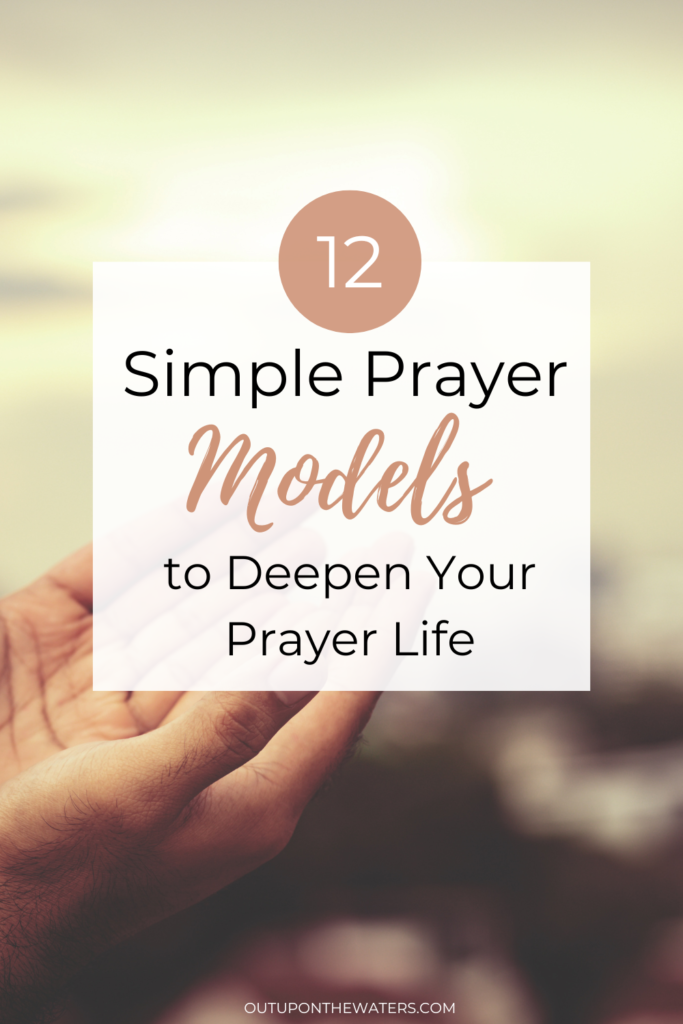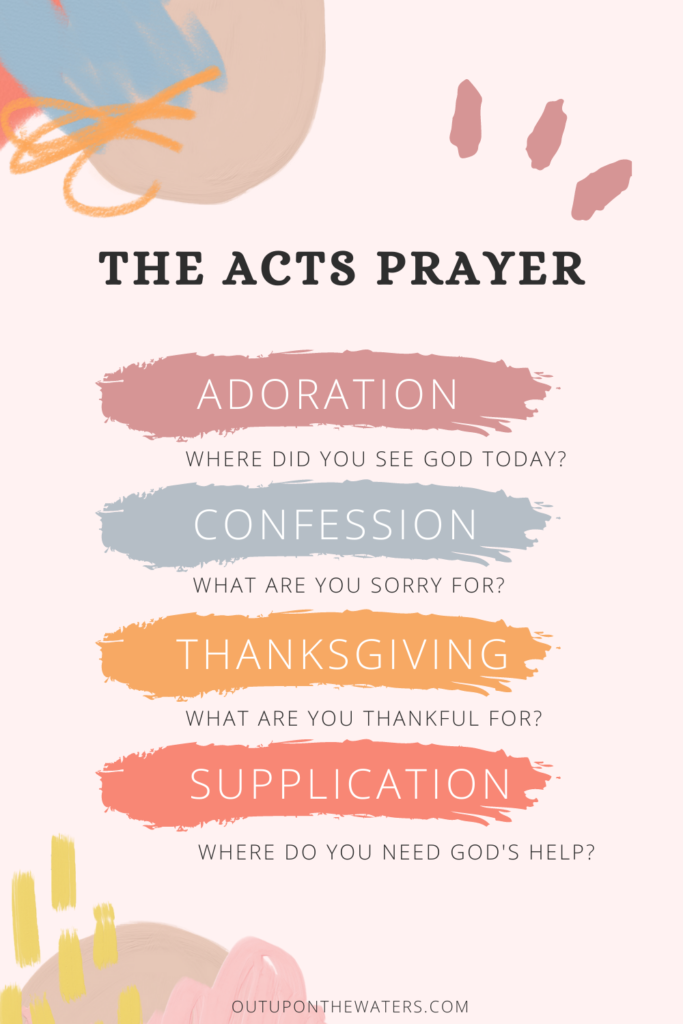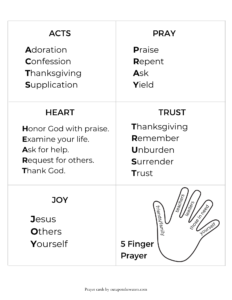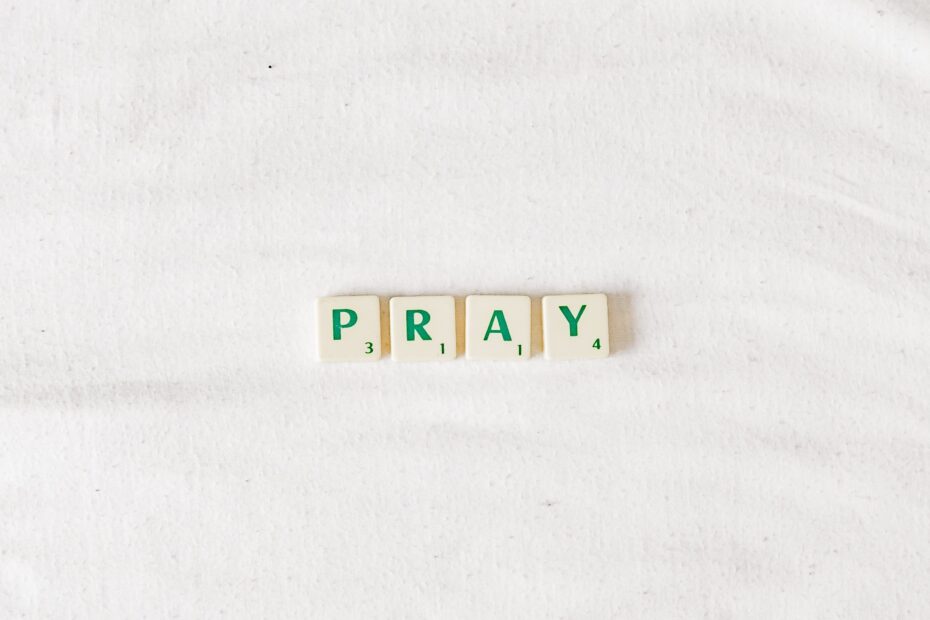If you are looking for some simple and enriching prayer models to deepen your prayer life, these prayer models and methods will offer you opportunities to structure your prayer time and explore more creative prayer methods. Try out some prayer models that use acronyms to give your prayer time some structure. Or learn how to do the doodle prayer or go for a prayer walk. These are great prayer models for whether you have five minutes to pray or an hour. Some of these prayer models encourage you to go deeper in your conversation with God, and some encourage creativity in how we interact with God. These are all great ways to improve your prayer life.
To download these simple prayer models as printable prayer cards, scroll to the bottom of this post.
[Disclaimer: This post contains affiliate links. Using these links means I may earn a percentage of the purchase at no extra cost to you. As an amazon associate, I receive a percentage of qualifying purchases. View our disclosure policy here.]

The ACTS Prayer Model
The ACTS prayer model is a simple practice that can help give structure to your prayer time. ACTS stands for adoration, confession, thanksgiving, and supplication.
- Adoration. Focus on God’s character and His attributes. Still your mind, focus on God, and remind yourself of who He is. You can praise God for being our Creator and Redeemer, for being the source of wisdom, for being our loving protector, or any other of God’s attributes. Maybe there is something about God that you especially appreciate or need today. If you have trouble finding an attribute of God to praise Him for, you can also focus on where you have seen God in your life.
- Confession. Confess any sins that you have, say sorry for something that you’ve done or not done. Sometimes this is a concrete confession: I yelled at my kids yesterday; I didn’t truly listen to a friend last week, and jumped too quickly to my own opinions; I bought a new pair of shoes (that I don’t need) with the money I should be tithing…. Or it could be a general trait: I wasn’t very patient today. I realize that I am focused too much on financial security and I trust a paycheck more than I trust you, God.
- Thanksgiving. Name something (or many things) that you are thankful for. Acknowledge the good in your life. It could be something good that happened today, a modern convenience that you normally take for granted, a loved one, etc.
- Supplication. Ask God for what you need. This could be something that you are struggling with, something that you are excited about – or worried about – or something that you would like to happen. Also take this opportunity to pray for other people.

The PRAY Prayer Model
The PRAY prayer model is a simple prayer method that encourages you to praise God for who he is, repent of any sins or shortcomings, ask for help, and yield to God’s will.
- Praise. This is your opportunity to focus on who God is and how he has shown up in your life recently. We can praise God for who He is: loving, protector, provider, just, merciful…. We can praise him for where we see him in our lives. We can share with God any “wow” moments and recognize that all good things come from him.
- Repent. To repent is to change directions, to turn around, and it signifies a change in your relation to God. Confess any sins, shortcomings, and mistakes that you have made. Those may be concrete confessions like “I yelled at my kids yesterday,” or “I chose to spend my time scrolling social media instead of in Bible study and prayer.” Or it may be something more general, like “I could be more patient,” or “I could be more kind with my words.”
- Ask. Bring your requests to God. Ask Him to help you with any challenges you are facing, ask for provision and protection, pray for those around you who need God’s help. Shares your worries, your needs, and your challenges with Him. Pray also for family, friends, coworkers, classmates, the poor, the lonely, those in your city, and around the world.
- Yield. Yield to God’s will. Slow down, sit in silence for a few minutes, and listen to what God might have to say. Lay down all your cares and concerns, and try to sit in quiet without going through your list of things you need to do, worries, and responsibilities. Take a few deeps breaths and just sit in the presence of your Creator.
At the end of your prayer time, remember that it is not your will that God will do, but his own. Try to yield your will to his. Acknowledge that he knows what is best and he knows the whole story. Remember that Jesus, too, prayed for that he would not have to face the suffering that he knew was coming, but concluded “not my will, but yours be done” (Luke 22:42).

The HEART Prayer Model
The HEART prayer model gives some structure to your prayer time by having you focus on who God is, examine areas where you need growth or change, ask for help for yourself and others, and thank God for the good things in your life.
- Honor God with praise. Who is he? What does he do? How do you see or feel him in your life?
- Examine your life. Take a moment to examine your life and to ask God to help you see any areas where you need growth. Confess any sins or shortcomings, any mistakes that you made.
- Ask for help. Ask God for help with the things that are important to you. Pray for guidance, for strength to overcome any struggles you face, for wisdom and insight if you are facing a decision, etc.
- Request for others. Pray for the people in your life. Ask God to bless them, to protect them, and to meet their needs.
- Thank God. Thank him for the things he has done and for the good things and the people you love in your life.
The TRUST Prayer Model
The TRUST prayer model is a simple method that encourages you to thank God for who he is and remember when he has come through for you in the past, before asking for what you need in the present. The TRUST prayer model focuses on surrendering your will to God’s will and trusting that he will work all things out in the end.
- Thanksgiving. Thank God for who he is. Recall some attributes of God: He is sovereign Creator, loving Father, shepherd, etc. Thank God for his guidance, wisdom, protection…
- Remember. Remember the things that God has done in your own life. Remembering God’s faithfulness in the past will help you to trust him in the future.
- Unburden. Unburden your heart and ask God for help. Tell him your challenges, your needs, your worries. Pour out your needs and your requests to God.
- Surrender. Surrender to God’s will. Remember that it is ultimately God’s will that will be done, and that God’s plan may be different from your plan. Ask God to help you to surrender your own will to his.
- Trust. Place your trust in God. Trust that he will answer your prayer, and that he will work all things together for good. Even when things don’t go according to your plan, ask God to help you to trust in his plan.

Download your free printable prayer model cards here.

The JOY Prayer Model
The JOY prayer acronym stands for Jesus, Others, Yourself. This is a simple acronym that reminds us to put Jesus first, and then others before ourselves.
- Jesus: Begin your prayer by praising Jesus for who he is. You can thank Jesus for an attribute that is especially close to your heart. For example: Thank you, Jesus, that you welcome the little children, if you are in a season with small kids in your life. You can thank him for or reflect on an attribute that you need to rely on at this particular moment. For example: Thank you, Jesus, that you are the Prince of Peace (Isaiah 9:6). I really need some peace in my life right now.
- Others: Pray for the needs to others. This could be friends, family, coworkers, classmates, people in your city, or people far away in the world.
- Yourself: Pray for yourself and your own needs. Tell God what you are struggling with, where you need help or guidance, what you are excited or thankful for….
The Five Finger Prayer
The five finger prayer model is really simple. Each finger represents a group of people for whom you can pray. You can open your prayer time with “Dear God,” or however you normally open prayer. As you pray, go through each of the fingers (and thumb) on your hand. Pray for the people those fingers represent.
- Thumb: Pray for those closest to you: your family and friends.
- Pointer finger: Pray for those who point you in the right direction: your teachers, and other leaders in your life. Pray for wisdom and support.
- Middle finger (tallest): Pray for those that lead us: those in government, in business, in church leadership. Pray for guidance and wisdom.
- Ring finger (weakest): Pray for those who are poor, sick, in pain, in trouble: those most in need.
- Pinkie finger (smallest): Pray for ourselves and out own needs.

The Five Finger Daily Examen
The daily examen is a simple prayer model that encourages reflection on our day in the presence of God. The daily examen is like a review of our day, where we notice what happened, how we felt, and we lift everything up to God. The five finger daily examen matches each step of the examen with a finger on your hand to help you remember the steps.
- Be still. Our thumb reminds us of what is important. Notice your breath, try to still your mind, and be present to God and yourself.
- Be grateful. As our index finger points things out to people, reflect on your day and point out everything you’re grateful for.
- Notice. Our middle finger is usually the longest and the one that stands out. What stood out to you today? Where have you felt happy today? Sad? Frustrated? Were there any challenges today? Any victories?
- Ask for help. Our ring fingers are where we put our wedding rings. Think about your responsibilities and promises you have made. What do you need God’s help with? Is there anything you need to say sorry for?
- Look ahead. Our pinky finger is our smallest one. Sometimes a small change can make a big difference. Think about tomorrow. What do you hope for? Are there any little changes that you can make?

Listening Prayer
Listening prayer is a simple prayer model that helps to still your mind and focus on God. Most of your time spent in listening prayer will be spent sitting in quiet and listening for God.
- Set aside some quiet time when you can focus.
- Take a few deeps breaths to clear your thoughts. Focusing on your breath can help to calm the inner noise.
- Ask God to be with you in the silence and to speak to your heart. Ask him to be with you in the silence. Ask if he has anything he would like to say to you. If there is something that is weighing on your heart that you would like to pray about, tell God about it.
- Sit in silence and listen for God. Start with 3 minutes and work your way up to more. This is the “listening” part of the prayer. Sit in silence and listen for God. Total silence and stillness will be hard, especially if you are not used to this type of prayer. Start with 3 minutes and work your way up to more. To prevent yourself from constantly interrupting your silence with thoughts of “How long has it been?”, set a timer.
- When your mind wanders, gently acknowledge the distraction and return your attention to your breath.
- Take note of what God places on your heart. This may be Scripture or a song that comes to mind, or maybe an impressions, ideas, or pictures that God gives you. Recording your experience in a prayer journal is an excellent way to keep track of what God is saying to you. It’s always good to check your impressions against Scripture, as well.
Seth Barnes, in The Art of Listening Prayer, notes that this type of prayer “contains the potential for mistaking ordinary thoughts for the voice of God. But the important thing is that you are giving God the opportunity to speak to you. Just as children must be taught to listen and to sit respectfully during adult conversation, so we must learn to stop our one-way monologues with our heavenly Father” (page 29-30).
As you practice listening to God, combined with a consistent Bible study practice, you will learn to be able to pick out God’s voice from your own: just like the sheep learn to recognize the shepherd’s voice in Jesus’ parable of the good shepherd.
The Lord’s Prayer
When Jesus is instructing his disciples on how to pray, he gives them the model that we now call the Lord’s Prayer. This is an excellent prayer model that can be prayed word for word or used as a template to guide our own personal prayer.
The Lord’s Prayer
Our Father in heaven,
hallowed be your name,
your kingdom come,
your will be done,
on earth as in heaven.
Give us today our daily bread.
Forgive us our sins
as we forgive those who sin against us.
Lead us not into temptation
but deliver us from evil.
For the kingdom, the power,
and the glory are yours
now and forever.
Amen.
There are eight key moments in the Lord’s Prayer that can help to structure our own personal prayer time and to pray like Jesus did.
- Focus on relationship: The Lord’s Prayer begins by recognizing our relationship with God as Father. We can begin our time in prayer in the same way.
- Worship God: Worship God for who he is and what he’s done for you.
- Let God’s will take priority: Ask God for his plan to take precedence over your own. Pray that God’s will will be done and ask him to help you to align your will and your desires with his. Pray that God’s kingdom and his vision would become a reality on earth.
- Ask for provision: Ask God to meet your needs. Be honest and transparent. Tell God what you are struggling with, where you need help or guidance, etc. Remember that Jesus tells us to pray for our daily bread. Pray for what you need today.
- Ask for forgiveness: Confess and repent of any sins that may be between you and God and confess any shortcomings, failures, or things that you struggle with (like being patient, listening to others, etc.). Extend forgiveness to others who have hurt you, or ask God to help you to forgive.
- Ask for awareness: Ask God for eyes to see any areas that could be potential pitfalls or that could cause you difficulty.
- Ask for protection: Ask God for protection and deliverance from the attacks of the enemy, recognizing your dependance on him. Ask for protection and guidance if you are facing difficult circumstances.
- Affirm God’s sovereignty: End your time in prayer by recognizing God’s sovereignty over all things.
The Everyday Prayer
The everyday prayer is a short prayer model that you can do in 5 minutes each day. It can help to ground you, to remind you of what you have to be thankful for, and to listen to God’s leading in your life.
- Presence: Settle yourself. Get into a comfortable position. (Sitting and with good posture is a good idea.) Close your eyes or shift your gaze to the floor. Take 5 slow, deep breaths and shift your focus to God. Try to let distracting thoughts and noises just float past you. If your mind wanders, bring it back to the present moment (but without judgment or worry). Silence. (30 seconds)
- Thankfulness: Bring to mind one thing that you have to be thankful for. Silence. (30 seconds)
- Ask: Ask God for one thing that is on your heart. Silence. (30 seconds)
- Forgiveness: Recall one thing for which you are sorry and are holding onto. Silence. (30 seconds)
- Listen: Sit in silence for at least 30 seconds and be open to God.
- End: Amen.
The Doodle Prayer
The Doodle Prayer is a simple and creative way to structure your prayer time and lift up people and situations in your life to God. This prayer model is great for those who like to draw or color, to pray on the go, and for those who want a few minutes of quiet time to reflect on their prayers. To do the doodle prayer, all you need is a piece of paper, or a prayer journal, and some colored pencils, markers, etc.
- Write out your prayer. This doesn’t have to be in full. Writing names of people for whom who have a responsibility to pray, and snippets of situations where you need divine help and guidance, is more than enough.
- Doodle around your prayers. This can be as simple as adding colour to words, underlining, drawing borders, etc. You can also draw pictures and doodle around your words. The goal is not necessarily to make your prayers pretty. The goal is to keep your mind focused on the person or the situation at hand as you pray. Colouring and drawing can help you do that.
- Place your hand over each prayer in turn and lift that person or situation up to God. Ask for his presence. And give yourself a few moments of silence after each prayer.
- End. Amen.
Prayer Walk
A prayer walk is a great way to move physically through a space and pray for the people and situations that arise there.
- Choose a location that you’d like to pray over. Consider your neighborhood, your church, the rooms of your home, your office, or your school.
- As you physically walk pray over the people, situations, circumstances, the work done here, and the needs that come to mind. Ask God’s blessing and hand on each one.
- As you close in prayer, thank God for the people and the places that you have been praying for.


I appreciate that you also mention the prayer walk. Sometimes, I struggle sometimes with it, because it is not feeling like praying in my bedroom.
Thanks for sharing your experience, Aritha! Indeed, prayer that isn’t sitting in silence, talking to God, can feel very strange and different. Over time, the creative types of prayer practices, and things like prayer walks, have become some of my favorites. For a long time, I didn’t know that could be “prayer”.
Thanks for sharing this beautiful article on prayer. There are two I would like to try out… the listening prayer and the doodle prayer. I love the prayer walk too which i have tried inside my home walking through the rooms.
I’m so glad you found some new ideas here. I love the doodle prayer! I find it helps to keep me focused and it satisfies my artsy-craftsy side. 🙂 Prayer walking through your home is such a good idea!